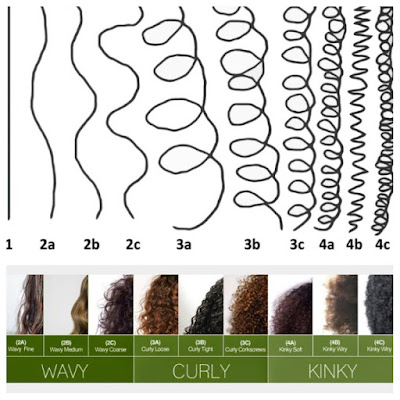Oh, the elusive Curl Type... so complicated, as there are so many ways of explaining. It's truly confusing, but we do our best. And in the end, it does not matter which curl type you have. Just keep them healthy, no matter the texture.
Warning
This can be very confusing to learn about, as there seem to be discrepancies between the curly experts and the websites.
Basically
Curls are divided into three families:
 You can have more than one curl type on your head at any given time. I have mainly 2C (very wavy) with some 3A (loose curly) I even have some straighter 2A that hang around my face. I call my hair Swavy as the waves make S patterns.
You can have more than one curl type on your head at any given time. I have mainly 2C (very wavy) with some 3A (loose curly) I even have some straighter 2A that hang around my face. I call my hair Swavy as the waves make S patterns.
Warning
This can be very confusing to learn about, as there seem to be discrepancies between the curly experts and the websites.
Basically
Curls are divided into three families:
- Wavy - Type 2
- Curly - Type 3
- Kinky-Curly - Type 4
- Straight hair (with no hope for a curl) is Type 1.
 |
| Still looking for the original source |
Each curl family is divided into three categories: A, B and C.
A is always on the looser end, and C is on the curlier end.
So, we have:
Wavy: 2A, 2B,2C
Curly: 3A, 3B, 3C
Kinky-Curly: 4A, 4B, 4C
 |
| Credit: Adunni Organics |
This doesn't mean that Wavy isn't curly! "Wavy" just distinguishes one type of curl from another on the curl spectrum. Wavy curls resemble an S rather than a coil. Kinky-Curly is the curliest of all.
 You can have more than one curl type on your head at any given time. I have mainly 2C (very wavy) with some 3A (loose curly) I even have some straighter 2A that hang around my face. I call my hair Swavy as the waves make S patterns.
You can have more than one curl type on your head at any given time. I have mainly 2C (very wavy) with some 3A (loose curly) I even have some straighter 2A that hang around my face. I call my hair Swavy as the waves make S patterns.
Personal Experience
When I first learned I had "Wavy" hair, I was dismayed. I spent most of my life trying to deal with curly hair, whether it was to tame it or straighten it; my self confidence; not feeling pretty or attractive, etc.
And then the Curly Girl Method/CGM helped me LOVE my hair.
I had always envisioned "wavy" hair as mainly straight with a slight ripple. Not my temperamental curls.
BUT.... I learned through the curly community on Instagram that "wavy" curls are STILL CURLS. It's just a descriptor as there are so many varying degrees of curl out there.
Curl Pattern vs Hair Type
While knowing your curl type can either validate your experience or give you comfort in knowing where on the curl spectrum you stand, it really isn't the most helpful indicator to figure out how to care for your hair.
Porosity, density, follicle size, protein sensitivity, dew points, etc. are what you need to know and learn over time to get the best results for your hair. Knowing these will lead you to the right products and techniques for your hair type.

Comments
Post a Comment